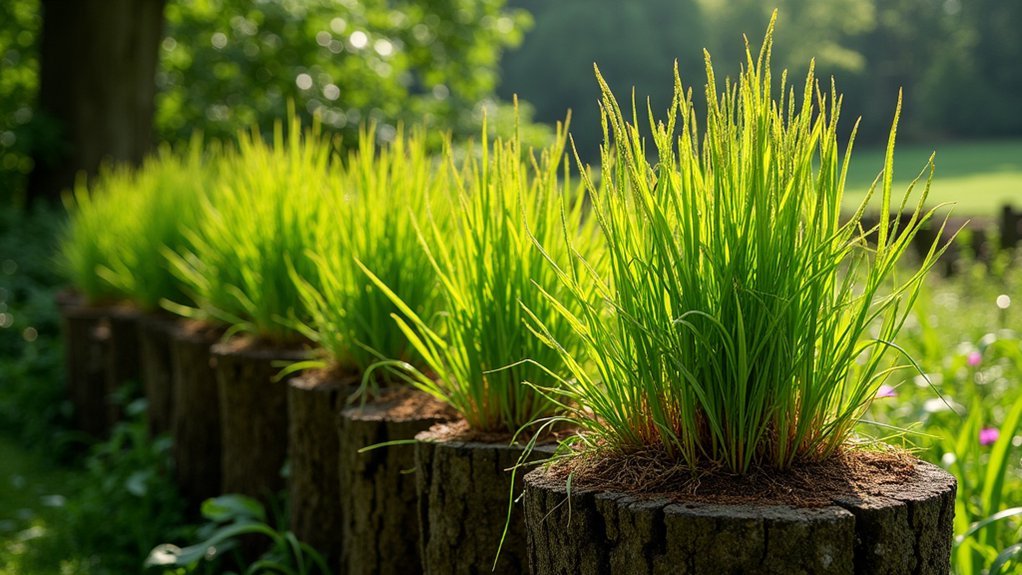The three best coppicing methods for hedge material are traditional stool coppicing, rotation coppicing, and selective side-cutting. Traditional stool coppicing creates dense hedges by cutting trees at ground level to stimulate multiple shoots. Rotation coppicing divides your hedge into sections cut on a staggered schedule, ensuring continuous material supply. Selective side-cutting develops a unique layered structure through angled cuts on flexible stems. Each technique offers specific benefits for boundary creation, sustainable materials, and wildlife habitat enhancement.
Traditional Stool Coppicing for Dense Hedge Formation

When you’re looking to create a robust, impenetrable hedge, traditional stool coppicing stands as one of the most effective techniques in the hedgelayer’s arsenal. This woodland management practice involves cutting young trees at ground level, creating a stool from which multiple shoots emerge during the first year of new growth.
Native species like hazel, sweet chestnut, and ash trees respond particularly well to this treatment. You’ll need to implement regular pruning every 3-5 years, which stimulates vigorous regrowth and maintains the dense hedge structure you desire.
Beyond creating effective boundaries, properly coppiced hedges provide essential habitats for diverse flora and fauna while offering you a sustainable source of firewood.
The multiple poles that sprout from each stool interweave naturally, creating a living fence that improves with each cutting cycle.
Rotation Coppicing for Sustainable Hedge Materials
While stool coppicing creates dense hedges from individual plants, rotation coppicing takes this practice to a larger scale.
Scaling up from single plants to entire landscapes, rotation coppicing transforms hedgerows into sustainable resource systems.
You’ll divide your hedge into sections (coupes) and cut them on a staggered schedule spanning 8-20 years, depending on species. Hazel thrives on an 8-year cycle, while sweet chestnut needs 15-20 years.
This approach guarantees you’ll always have hedge materials at different growth stages, providing a continuous supply of poles for fencing and firewood.
It’s not just about materials—rotation coppicing creates a mosaic of habitats that enhance biodiversity in your landscape.
For vigorous regrowth, cut during the dormant season in late winter or early spring.
Protect young shoots from herbivores during their initial growth phase to maintain a sustainable, healthy hedge system.
Selective Side-Cutting for Layered Hedge Structure

Unlike conventional trimming methods, selective side-cutting creates a uniquely structured, multi-layered hedge that remains vibrant for decades.
You’ll want to perform this technique during late winter or early spring when plants are dormant, minimizing stress to your coppiced wood.
Make precise angle cuts on healthy flexible stems (pleachers) to create hinges that allow branches to bend while still receiving nutrients.
These angled cuts encourage new vertical growth from the sapling, effectively filling gaps in the hedge.
Always maintain a clean horizontal surface above the hinge for optimal development, improving light penetration and air circulation.
For best results, implement this technique every 10-20 years to develop a robust layered hedge structure that provides excellent shelter and food for wildlife throughout the seasons.
Frequently Asked Questions
How Do You Coppice a Hedge?
You’ll need to cut stems to 15-30cm above ground during winter dormancy, using sharp tools for clean cuts. Protect new growth from animals and maintain by repeating every 3-5 years.
What Is the Best Wood for Coppicing?
Native woods like hazel are your best coppicing choices. You’ll get excellent results with sweet chestnut, ash, hornbeam, and willow too. They’ll regrow vigorously after cutting, providing sustainable wood for various uses.
What Are the Disadvantages of Coppicing?
When you’re coppicing, you’ll face challenges like biodiversity reduction, temporary habitat loss, and labor-intensive maintenance. It requires specialized knowledge, and trees can weaken if cut too frequently. Wildlife like deer may damage regenerating shoots too.
What Is the Difference Between Pollarding and Coppicing?
You’ll find the main difference is height: coppicing cuts trees at ground level for multiple stems, while pollarding cuts at 8-10 feet high for elevated regrowth that’s less vulnerable to animal browsing.
In Summary
You’ll find success with any of these three coppicing methods. Traditional stool coppicing creates thick, impenetrable barriers, while rotation coppicing guarantees you’ve always got fresh material available. Selective side-cutting gives you those beautiful layered hedges with minimal effort. Choose the technique that matches your specific needs and available time. With proper timing and tools, you’ll enjoy robust, living hedges that improve with each passing year.





Leave a Reply